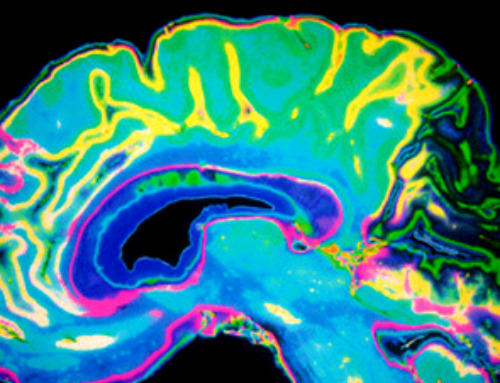Inflammation of the arteries is a primary precursor and driver of cardiovascular disease—the No. 1 killer of people in the United States. This inflammation is associated with the buildup of dangerous plaque inside the arteries. Advanced treatments are needed to target this inflammation in patients. Michigan State University researchers have tested a new nanoparticle nanotherapy infusion that precisely targets inflammation and activates the immune system to help clear out arterial plaque.
“There are two different things that people seem to be scared of when it comes to plaques,” said Bryan Smith, an associate professor with the Department of Biomedical Engineering in the College of Engineering and MSU’s Institute for Quantitative Health Science and Engineering. “Many people don’t really understand the difference between them.”
The first example is when your artery becomes blocked (for example, a 95% to 99% blockage). Often, there are symptoms like pain or pressure in the chest or nausea and dizziness beforehand and doctors will put a stent in the artery to increase blood flow. The second is when the plaque is highly inflammatory. This can make the plaque vulnerable to rupture, which can lead to artery blockages elsewhere in the body.
“That’s the scarier one that leads to most heart attacks,” said Smith. “Because such plaques don’t necessarily block much of the artery, and because the effects of the rupture can very suddenly completely block blood flow, such a heart attack can seem to appear as if from nowhere.”

Smith and his team, including co-first authors postdoctoral fellows Yapei Zhang and Manisha Kumari, created nanoparticles—materials that are thinner than a human hair—that they used to develop a nanotherapy infusion. The nanotherapy selectively targets a specific immune cell type that moves into and is a part of the plaque. These treated cells “eat” away parts of the plaque core, removing it from the artery wall and decreasing levels of blood vessel inflammation.
Previous studies by Smith and his collaborators, the Leeper Lab at Stanford University, tested the infusion on mice and now, pig models, to prove the infusion’s effectiveness, and critically, its lack of side effects due to its precision immune targeting.
“Using PET [positron-emission tomography] scans, we were able to measure the effects of the therapy on pig arteries,” said Smith. “We showed in animal models such as pigs that we can decrease the levels of inflammation in the plaque based not only on this clinically used PET imaging technique but also by molecular assays. Just as importantly, we saw none of the side effects that would have been anticipated had the therapy not been precisely targeted.”
Earlier studies in mice required hundreds of microliters of the nanotherapy infusion, but most recently, Smith and his team have achieved a measurable impact in pigs by scaling up the amount produced to liters. These volumes are in the range needed for human use. This study represents a critical step toward translation to patient clinical trials of safer, more effective cardiovascular therapies.
More information: Sharika Bamezai et al, Pro-efferocytic nanotherapies reduce vascular inflammation without inducing anemia in a large animal model of atherosclerosis, Nature Communications (2024). DOI: 10.1038/s41467-024-52005-1
Journal information: Nature Communications
News
Researchers highlight five pathways through which microplastics can harm the brain
Microplastics could be fueling neurodegenerative diseases like Alzheimer's and Parkinson's, with a new study highlighting five ways microplastics can trigger inflammation and damage in the brain. More than 57 million people live with dementia, [...]
Tiny Metal Nanodots Obliterate Cancer Cells While Largely Sparing Healthy Tissue
Scientists have developed tiny metal-oxide particles that push cancer cells past their stress limits while sparing healthy tissue. An international team led by RMIT University has developed tiny particles called nanodots, crafted from a metallic compound, [...]
Gold Nanoclusters Could Supercharge Quantum Computers
Researchers found that gold “super atoms” can behave like the atoms in top-tier quantum systems—only far easier to scale. These tiny clusters can be customized at the molecular level, offering a powerful, tunable foundation [...]
A single shot of HPV vaccine may be enough to fight cervical cancer, study finds
WASHINGTON -- A single HPV vaccination appears just as effective as two doses at preventing the viral infection that causes cervical cancer, researchers reported Wednesday. HPV, or human papillomavirus, is very common and spread [...]
New technique overcomes technological barrier in 3D brain imaging
Scientists at the Swiss Light Source SLS have succeeded in mapping a piece of brain tissue in 3D at unprecedented resolution using X-rays, non-destructively. The breakthrough overcomes a long-standing technological barrier that had limited [...]
Scientists Uncover Hidden Blood Pattern in Long COVID
Researchers found persistent microclot and NET structures in Long COVID blood that may explain long-lasting symptoms. Researchers examining Long COVID have identified a structural connection between circulating microclots and neutrophil extracellular traps (NETs). The [...]
This Cellular Trick Helps Cancer Spread, but Could Also Stop It
Groups of normal cbiells can sense far into their surroundings, helping explain cancer cell migration. Understanding this ability could lead to new ways to limit tumor spread. The tale of the princess and the [...]
New mRNA therapy targets drug-resistant pneumonia
Bacteria that multiply on surfaces are a major headache in health care when they gain a foothold on, for example, implants or in catheters. Researchers at Chalmers University of Technology in Sweden have found [...]
Current Heart Health Guidelines Are Failing To Catch a Deadly Genetic Killer
New research reveals that standard screening misses most people with a common inherited cholesterol disorder. A Mayo Clinic study reports that current genetic screening guidelines overlook most people who have familial hypercholesterolemia, an inherited disorder that [...]
Scientists Identify the Evolutionary “Purpose” of Consciousness
Summary: Researchers at Ruhr University Bochum explore why consciousness evolved and why different species developed it in distinct ways. By comparing humans with birds, they show that complex awareness may arise through different neural architectures yet [...]
Novel mRNA therapy curbs antibiotic-resistant infections in preclinical lung models
Researchers at the Icahn School of Medicine at Mount Sinai and collaborators have reported early success with a novel mRNA-based therapy designed to combat antibiotic-resistant bacteria. The findings, published in Nature Biotechnology, show that in [...]
New skin-permeable polymer delivers insulin without needles
A breakthrough zwitterionic polymer slips through the skin’s toughest barriers, carrying insulin deep into tissue and normalizing blood sugar, offering patients a painless alternative to daily injections. A recent study published in the journal Nature examines [...]
Multifunctional Nanogels: A Breakthrough in Antibacterial Strategies
Antibiotic resistance is a growing concern - from human health to crop survival. A new study successfully uses nanogels to target and almost entirely inhibit the bacteria P. Aeruginosa. Recently published in Angewandte Chemie, the study [...]
Nanoflowers rejuvenate old and damaged human cells by replacing their mitochondria
Biomedical researchers at Texas A&M University may have discovered a way to stop or even reverse the decline of cellular energy production—a finding that could have revolutionary effects across medicine. Dr. Akhilesh K. Gaharwar [...]
The Stunning New Push to Protect the Invisible 99% of Life
Scientists worldwide have joined forces to build the first-ever roadmap for conserving Earth’s vast invisible majority—microbes. Their new IUCN Specialist Group reframes conservation by elevating microbial life to the same urgency as plants and [...]
Scientists Find a Way to Help the Brain Clear Alzheimer’s Plaques Naturally
Scientists have discovered that the brain may have a built-in way to fight Alzheimer’s. By activating a protein called Sox9, researchers were able to switch on star-shaped brain cells known as astrocytes and turn them into [...]





















